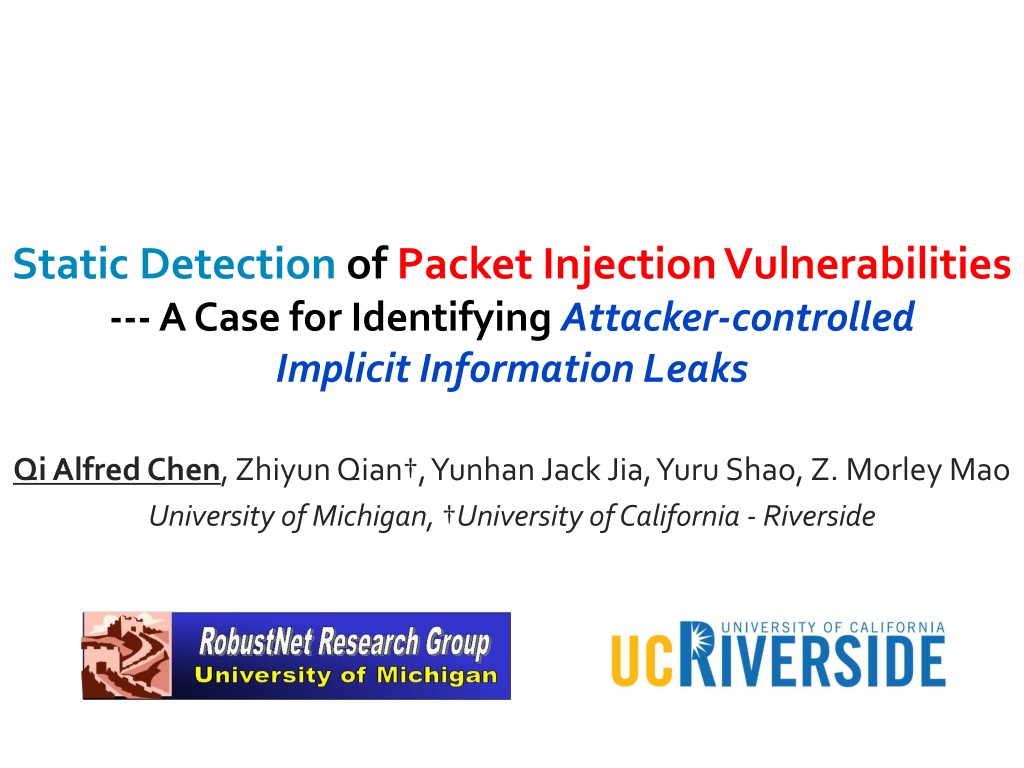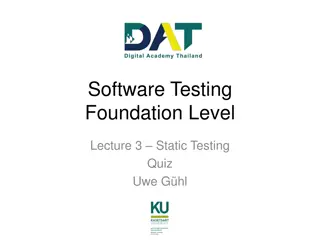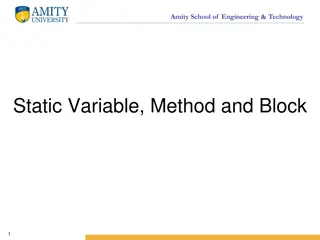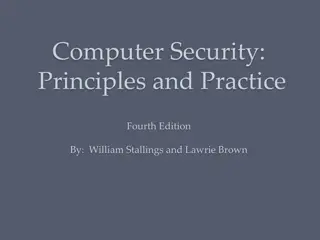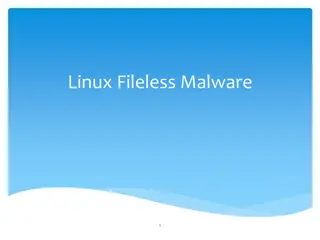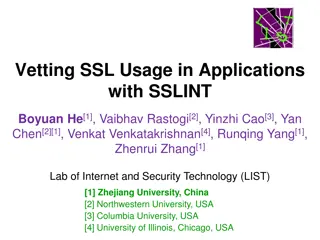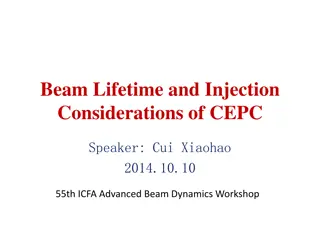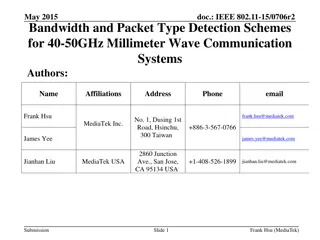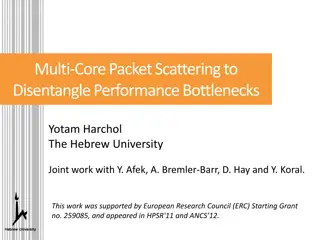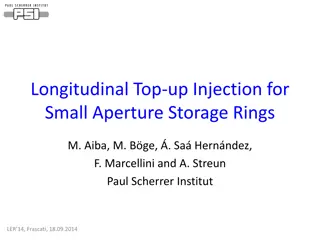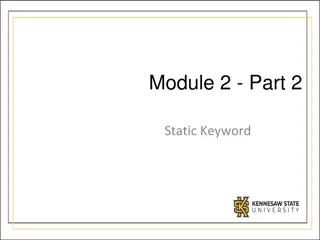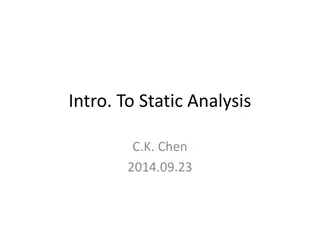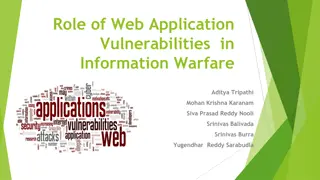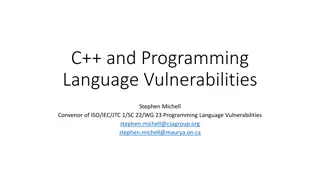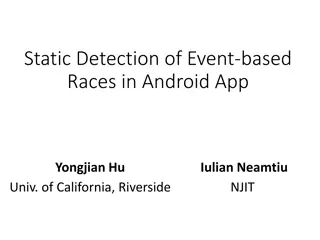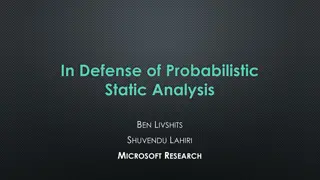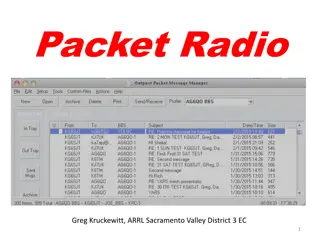PacketGuardian: A Tool for Static Detection of Packet Injection Vulnerabilities
This research paper introduces PacketGuardian, an effective static analysis tool designed to evaluate the robustness of protocol implementations against packet injection attacks. This tool supports precise context, flow, field-sensitive taint analysis, implicit flow analysis, and employs a summary-based approach for scalability. PacketGuardian aims to detect attacker-controlled implicit information leaks and requires access to source code for evaluation. It has been applied to six real protocol implementations uncovering vulnerabilities.
Download Presentation

Please find below an Image/Link to download the presentation.
The content on the website is provided AS IS for your information and personal use only. It may not be sold, licensed, or shared on other websites without obtaining consent from the author. Download presentation by click this link. If you encounter any issues during the download, it is possible that the publisher has removed the file from their server.
E N D
Presentation Transcript
Static Detection of Packet Injection Vulnerabilities ---A Case for Identifying Attacker-controlled Implicit Information Leaks Qi Alfred Chen, ZhiyunQian , YunhanJack Jia, YuruShao, Z. Morley Mao University of Michigan, University of California - Riverside
Packet injection attack Inject attack packet into an existing communication channel(TCP, RTP, etc.) Attacker is off-path: more realistic than MitM Off-path attacker Javascript injection HTTP XSS, CSRF TCP Phishing 2
Packet injection attack Application layer encryption Low coverage (only 30%) 1st HTTP request vulnerable to hijack[Qian, CCS 12] Vulnerable to DoS is limited Off-path attacker Javascript injection HTTPS HTTP TCP XSS, CSRF Phishing 3
Packet injection attack Application layer encryption Low coverage (only 30%) 1st HTTP request vulnerable to hijack[Qian, CCS 12] Vulnerable to DoS is limited HTTPS HTTP TCP 4
Current countermeasures To combat such threat, typically stringent checks are used E.g., RFC 5961 for blind in-window TCP attacks However, even if design is secure, the actual implementation may not always conform to it TCP code in Linux & FreeBSD found to be much weaker than RFC1 Windows-specific implementation enables fast sequence number cracking2 Calls for a systematic approach to verify network protocol implementations 1Qian et al., CCS 12 2Gilad et al., WOOT 12 5
Our solution: PacketGuardian An effective and scalable static analysis tool Systematically evaluate robustness of a protocol implementation against such attacks For high effectiveness, Support precisecontext, flow, field-sensitive taint analysis with pointer analysis Support implicit flow analysis The first topropose and detectattacker-controlled implicit information leaks For high scalability, Choose summary-based approach 6
Our solution: PacketGuardian Requires access to source code A realistic assumption for many key protocols Applied to 6 real protocol implementations Covering TCP, RTP, SCTP, etc. Discovered a set of vulnerabilities not previously reported 7
An illustrative example Entry point Handle incoming packets Packet acceptance point Copy payload to upper layer Terminate the channel Accept paths If any accept paths is weak, a vulnerability is directly revealed Handle_incoming_pkt(pkt) Check pkt.f1 Check pkt.f1 == 100? pkt.f1 Check pkt.f3 Check pkt.f2 accept_pkt() 8
An illustrative example If all accept paths have strong checks Usually protected by protocol states that are hard to guess A further question: will the protocol state be leaked to attacker? All recent TCP packet injection vulnerabilities exploit this! Handle_incoming_pkt(pkt) pkt.seq in win1 around Check pkt.f1 rcv_nxt? 232 pkt.ack in win2 around Check pkt.f3 snd_nxt? 232 accept_pkt() 9
An illustrative example If all accept paths have strong checks Usually protected by protocol states that are hard to guess A further question: will the protocol state be leaked to attacker? All recent TCP packet injection vulnerabilities exploit this! Collaborative attacker Crack TCP sequence number under 1 sec! (pkt.seq > rcv_nxt)? Y Binary search rcv_nxt Trigger public event, e.g., a storage channel N Bigger? Smaller? 10
A new class of implicit information leaks 1011 A unique implicit information leak Attacker data involved Classic implicit flow leaks Low exploitability SCD1 based leaks High exploitability (pkt.seq > rcv_nxt)? (attack_data > secret)? Y Trigger public event, e.g., a storage channel N A new class of highly-exploitable implicit information leaks! Call it attacker-controlled implicit information leaks We are the firstto propose and design a tool to detect it (secret == Const)? Crypto key extraction (e.g., in cloud) Side-channel leaks in web/ Android apps Collaborative attacker 11 1Bao et al., ISSTA 10
PacketGuardian design overview Static taint analysis Vulnerability analyzer Prioritize attacker- controlled implicit information leaks Accept path constructor Leak path constructor Highly- vulnerable leakage paths Weak accept paths Protocol states Packet injection Vulnerabilities Patch 3 Patch 1Patch 2 12
Static taint analysis Static taint analysis Taint engine High precision: flow, field, context sensitive Pointer analysis Implicit flow tracking Commonly excluded Summary-based approach High scalability Callee-to-caller order Lower complexity Makes taint path construction unnatural Solved by bookkeeping taint path info in path & tracking summary Function summary SCC generator - Taint - Pointer - Tracking - Path SCC Taint engine Pointer analysis 13
Vulnerability analyzer Static taint analysis Vulnerability analyzer Accept path Accept path constructor constructor Leak path constructor Function summary SCC generator - Taint - Pointer - Tracking - Path Highly- vulnerable leakage paths Weak accept paths Protocol states SCC Taint engine Pointer analysis Packet injection Vulnerabilities 14
Accept path analysis Taint source: Attack-controlled data Taint sink: Packet accept function Path & tracking summary Path pruning to reduce analysis efforts Prune weak checks E.g., compare with a constant Remove invalid paths Conflicting constraints on the path Remove stronger accept paths Accept paths with attacker-controlled data labelled 15
Vulnerability analyzer Static taint analysis Vulnerability analyzer Leak path Accept path constructor Leak path constructor constructor Function summary SCC generator - Taint - Pointer - Tracking - Path Highly- vulnerable leakage paths Weak accept paths Protocol states SCC Taint engine Pointer analysis Packet injection Vulnerabilities 16
Protocol state leakage analysis Taint source: Protocol state Taint sink: Attacker-observablechannels(storage/cache/timing/ ) First check explicit information leaks Then attacker-controlled implicit information leaks Track both protocol state and attacker-controlled data Prioritize high-entropy leakage High(pkt.seq > rcv_nxt)? Low (pkt.seq == rcv_nxt)? Y Low N (pkt.seq != rcv_nxt)? Trigger sink 17
Evaluation Implemented in OCaml Taint analysis part: ~15K LOC Vulnerability analyzer: ~2.8K LOC Analyzed 6 real code bases Linux kernel 3.15.8: TCP, SCTP, DCCP 3 implementations of RTP: oRTP, PJSIP, VLC Target storage channel (e.g., proc file) Tool efficiency results Longest: ~7.8 hours for Linux kernel TCP for taint analysis part 18
Evaluation Tool accuracy Accept path analysis Ground truth: all feasible accept paths No false negative (FN) paths Path pruning is effective (42.6% reduction) Protocol state leakage analysis For TCP rcv_nxt leakage TP # 4 FP # FN # 0 4 501 w/o field w/o implicit flow 0 N/A N/A 4 w/o pointer analysis 0 w/ all above (baseline) 4 0 0 19
Vulnerabilities found - TCP For these vulnerabilities, we have implemented the attack and validatedthem in a controlled test bed Linux kernel TCP rcv_nxt Find 4high-entropy leaks 1 reported before by manual inspection1, 3 new 4high-entropy leaks (3 new) 232/win1 32 snd_nxt/una Most recent reported leak is fixed after Linux 3.8 However, still find 13high-entropy leaks , all new Indicate the need for an automated tool like this 13high-entropy leaks (all new) 64 packets for a successful injection! 232/win2 32 20 1Qian et al., CCS 12
Vulnerabilities found - RTP 3 implementations of RTP oRTP, PJSIP, VLC: all claim to follow RFC 3550 Accept path analysis directly reveals vulnerability: oRTP, PJSIP: Only need 51 & 3 packets to inject payload VLC is well-protected by protocol state ssrc Leakage analysis: no storage channel leaks oRTP PJSIP VLC 3 51 232 Inject payload: Even these implementations follow the same RFC, their robustness against packet injection can be very different due to implementation details! 21
Summary PacketGuardian , an effective and scalable tool for systematic detection of packet injection vulnerability in protocol implementations The first to propose and detect attacker-controlled implicit information leaks A new class of highly-exploitable implicit information leaks Applied to 6 real code bases, and discovered new and realistic vulnerabilities on TCP, RTP, etc. In the future, plan to improve accuracy and study more protocols Our result website: http://tinyurl.com/PacketInjectionVulnerability 22
Questions? http://tinyurl.com/PacketInjectionVulnerability 23
